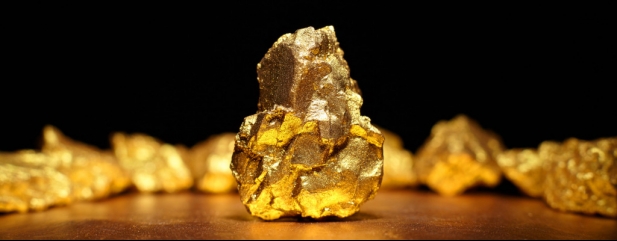Archived article
Please note that tax, investment, pension and ISA rules can change and the information and any views contained in this article may now be inaccurate.
Why gold has reached an all-time high

Gold has hit an all-time high of $1,980 per ounce as increasing numbers of jittery investors look for a safe place to put their money amid rising US-China tensions and a worsening economic outlook from the coronavirus pandemic.
At the time of writing, the spot price of gold stood at around $1,935 per ounce, eclipsing the previous all-time high of $1,921 per ounce set in September 2011, with the price of the shiny metal rising around 9% in the past month and 27% this year.

As well as general coronavirus worries and nervousness over relations between the US and China, analysts at Commerzbank say a driving force behind the big upswing in the gold price is a weaker US dollar, which has sunk to a two-year low on heightened concerns about the American economy.
When the dollar moves lower, gold often goes up as it becomes cheaper in other currencies.
The Commerzbank analysts also point to other factors such as growing investor concerns about currency debasement following a sharp rise in the money supply, as well as negative real interest rates.
In addition, highly valued stock markets – particularly ones in the US like the Nasdaq which hit an all-time high in June – have started to tail off in the past week, prompting inflows into gold and silver exchange-traded funds (ETFs). While not always the case in recent months, gold typically does well when the stock market falls.
DOWNSIDE RISKS TO CONSIDER
Those looking to take advantage of the strength in the gold price should consider some of the downside risks.
The Commerzbank analysts say the speed of gold’s upswing – its price has gained 5% in the past week – ‘should sound a warning bell’ as this can often precede a fall. While current momentum could persist, if gold goes above the $2,000 per ounce mark this could result in profit taking by investors, which could cause the price to dip again.
There is also the consideration that economies around the world could recover in line with current expectations or perhaps even better than expected, and/or an effective coronavirus vaccine comes to fruition in the next few months.
These factors could push the price of gold back down again, as such safe-haven assets wouldn’t be needed as much if the global outlook becomes rosier.
But on the flip side, certain indicators do suggest there are still legs in the gold rally.
The metal’s price only represents 0.59 times the value of the S&P 500’s value, barely half the post-1970 average of 1.14-times and pales next to the 1.6-times multiple gold reached at its previous all-time high in September 2011.
Also, there’s the argument that we could be facing the return of high inflation in developed economies, due to record low interest rates, quantitative easing, global supply-chain disruption and firms increasing prices to meet the extra costs of staying in business. This is another factor which would support a higher gold price as the metal has historically been a good hedge against inflation.

WAYS TO GET EXPOSURE
For those looking to invest in gold, two ways to get exposure are through an ETF or shares in a gold miner.
Gold ETFs have certainly delivered strong returns this year, with iShares Physical Gold (SGLN) for example returning 28.6% in the year to date.
Gold miners, a leveraged play on the commodity’s price, on the other hand have behaved differently, falling initially in line with the market but then rebounding stronger as gold jumped.
When the gold price soars such miners usually do well, both from a share price point of view and in terms of their earnings.
A high gold price can encourage junior miners to pick up projects that previously weren’t worth pursuing. While they may now be economically viable, investors should adopt a cautious stance towards any project that only works at the current high price. A pullback in the value of gold could quickly make these assets unappealing again.
Yamana Gold
Gold and silver producer Yamana Gold is set to return to the UK stock market in the coming months with a listing on the London Stock Exchange.
Currently valued at just under £5 billion (based on its New York listing), the Canadian miner will trade on London’s Main Market but it won’t be eligible for the FTSE indices.
Yamana joined AIM in 2003 and moved to the London’s Main Market in 2007. It delisted in 2013 as most of its shares traded on the Canadian and US markets.
The London market now only has a few gold miners of size and Yamana believes there is enough interest to warrant returning to the UK market.

Important information:
These articles are provided by Shares magazine which is published by AJ Bell Media, a part of AJ Bell. Shares is not written by AJ Bell.
Shares is provided for your general information and use and is not a personal recommendation to invest. It is not intended to be relied upon by you in making or not making any investment decisions. The investments referred to in these articles will not be suitable for all investors. If in doubt please seek appropriate independent financial advice.
Investors acting on the information in these articles do so at their own risk and AJ Bell Media and its staff do not accept liability for losses suffered by investors as a result of their investment decisions.
Issue contents
Editor's View
Feature
First-time Investor
Great Ideas
- Kainos up 50% since we said to buy, helped by knock-out trading update
- Our ‘buy’ call on resilient Texas Instruments gets off to solid start
- Coca-Cola shares are trading at a rare bargain level
- Recent share price dip is nothing to worry about with Tristel
- Keep buying AG Barr as latest update is very encouraging
- Knights set to lure top lawyers and their clients from rival law firms
 magazine
magazine








